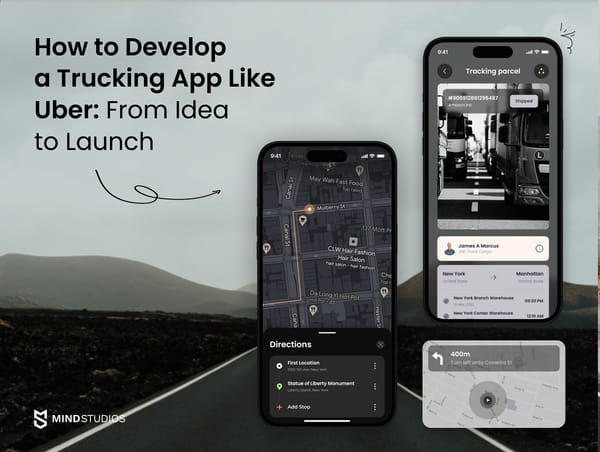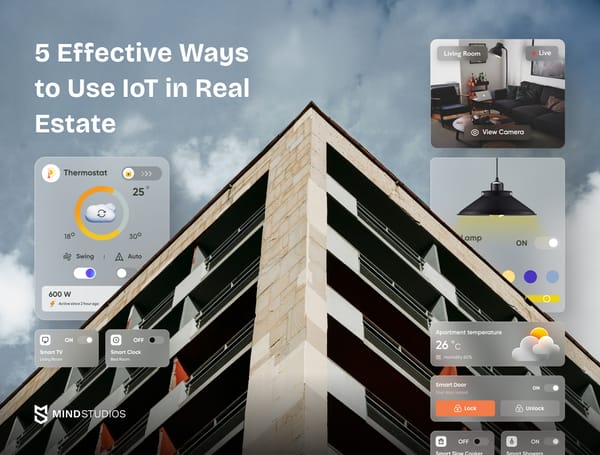Precision imaging, robotic surgery, genomic sequencing — healthcare technology trends are evolving at lightning speed, inevitably leading to patients having reasonably higher expectations of what their healthcare providers can offer. Medicine-related companies that want to stay afloat have to keep up, and this is exactly what this article aims to help with.
Here, you can explore Insights into the healthcare IT market, ideas for the implementation of current medical technology trends, and real-life examples that are already revolutionizing the industry.
Since one of Mind Studios’ focus industries is healthcare, many of the tips and insights shared here come from our own experience working building EHR & EMR systems, mHealth solutions, and more. So, if you have questions on how to get from an idea to implementation after reading this article, feel free to reach out.
Healthcare IT Market
The importance of investing in new medical technologies can be easily established by analyzing the market. According to Grand View Research, the global healthcare IT market was valued at USD 167.7 billion in 2022. From 2023 to 2030, it is projected to grow at a CAGR of 17.9%.
The key factors that are driving the health tech market include:
- Significant and rapid advancements in technologies like artificial intelligence, machine learning, IoT, and cloud computing
- Digital transformation of the healthcare industry caused by healthcare providers striving to improve efficiency and enable data-driven decision-making
- Rising demand for preventive medicine, which has shifted the focus from treating diseases to promoting health and well-being
- Patient empowerment and their willingness to take an active part in managing their health
- The evolution of network connectivity and network infrastructure coupled with increased healthcare IT spending
- Rising healthcare costs that result in the demand for more cost-effective solutions
- Support and incentives from governments and regulatory bodies that view health tech solutions as a way to boost patient outcomes and reduce costs in the long run
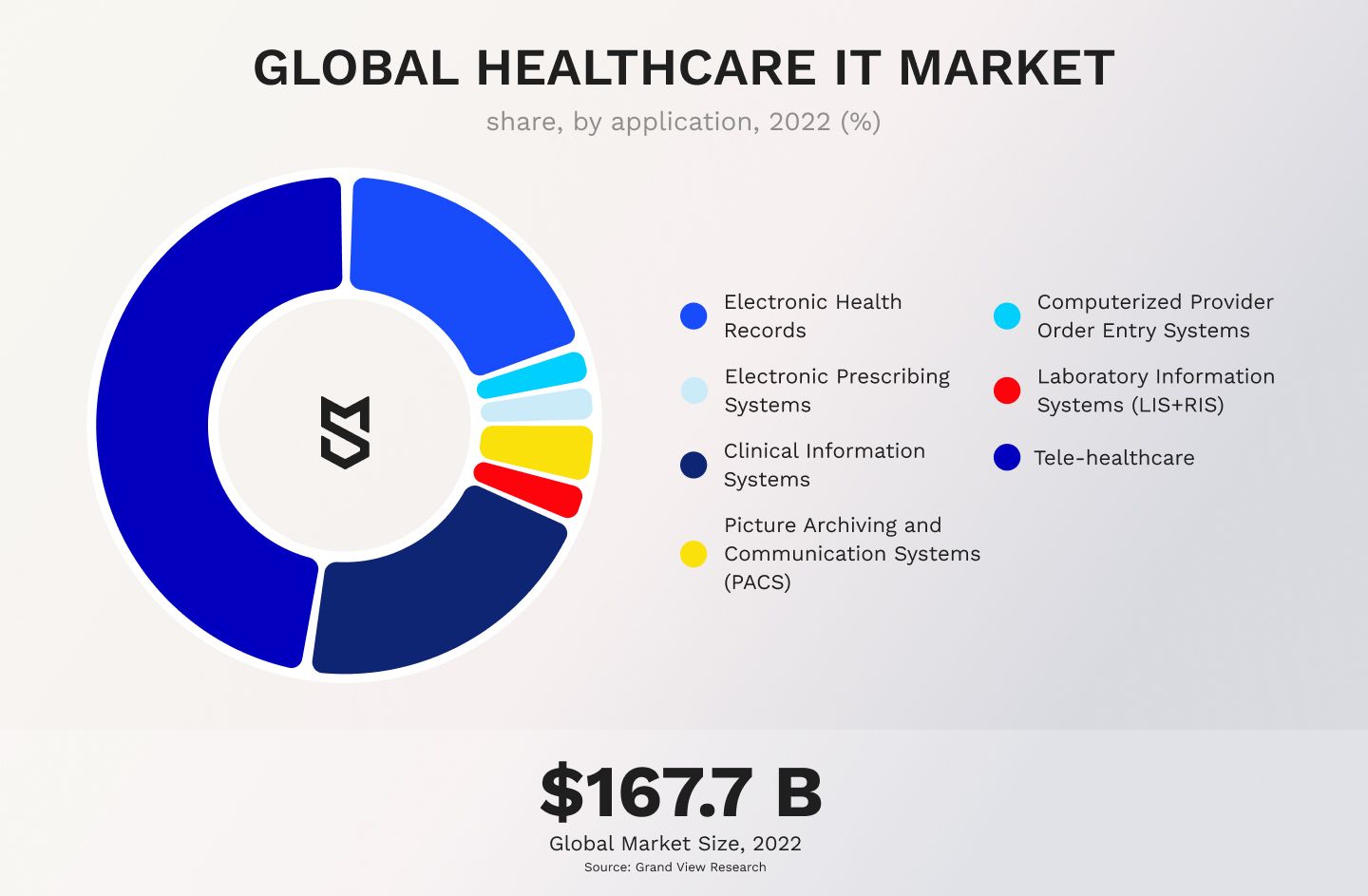
[Source: Grand View Research]
While the pandemic is over, remote healthcare platforms are its legacy that is staying for good. Telehealth is the apparent leader of healthcare tech solutions by application: in 2022, it accounted for a revenue share of 52.2%. The telehealth segment is expected to continue showing the fastest growth rate (23.5%) over the following years.
In addition to the increasing demand among patients for remote healthcare solutions, telemedicine platforms also help partially deal with the challenge of medical professionals shortage and the growing burden on healthcare systems.
Overall, many of the technology trends in healthcare mentioned in this article aim not only to improve healthcare quality but also to solve many challenges healthcare systems struggle with.
Top 8 emerging technologies in healthcare in 2025
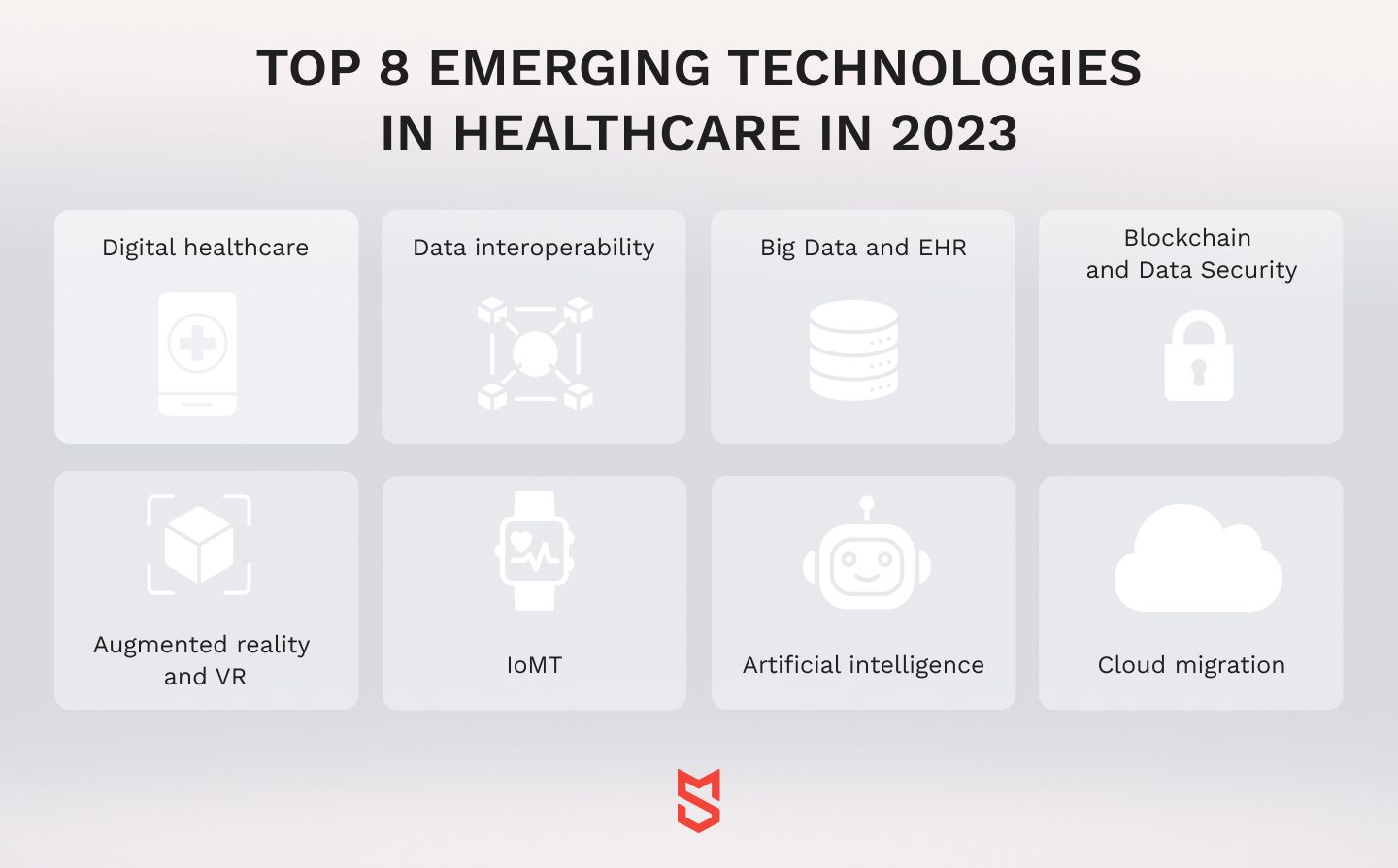
The technologies we’ve selected for this article can vary drastically in terms of implementation complexity and the budget they require. However, they all can potentially create a real long-term positive impact on healthcare organizations and the industry in general. So, let’s dive into what they are.
Artificial intelligence (AI)
In healthcare, AI covers a wide range of technologies, including computer vision, natural language processing, pattern recognition algorithms, machine learning, generative models, and more. So, it’s no wonder that the global AI in healthcare market size is expected to grow from USD 19.45 billion in 2022 to USD 280.77 billion by 2032.
AI solutions help HCPs analyze medical images more efficiently by using computer vision algorithms to spot anomalies early on. They also facilitate drug discovery through predictive analytics that helps foresee clinical trial outcomes. A recent AI breakthrough even helped a man with paralysis walk again through a brain-spine interface that employs a brain implant and an ML-powered thought decoder.
However, one of the most critical challenges AI now has to tackle is the optimization of clinical workflow, which can allow healthcare organizations to address workforce shortages.
According to data from the Association of American Medical Colleges, the US is projected to face a shortage of up to 124,000 physicians by 2034. In nursing, we can anticipate a global shortfall of 13 million nurses by 2030. These are just a few of many alarming numbers that demonstrate how serious the problem is.
So, what’s the role of AI in this crisis? One of the critical reasons for staffing shortage is burnout caused by inadequate workload and the job's extremely high-paced and stressful nature. Therefore, leveraging AI-enabled workflow automation is crucial for healthcare organizations that want to break the fall.
Medical imaging analysis, administrative tasks like appointment scheduling or insurance processing, EHR management, and patient triage are just a few tasks AI solutions can help with to free HCPs’ time.
Example. Some companies already apply AI in healthcare to enhance operational efficiency and support medical professionals. For instance, Aidoc, a health tech company, uses AI in medical imaging scans and prioritize urgent cases, which helps radiologists establish a more efficient workflow.
Digital healthcare: mHealth, digital therapeutics, telemedicine
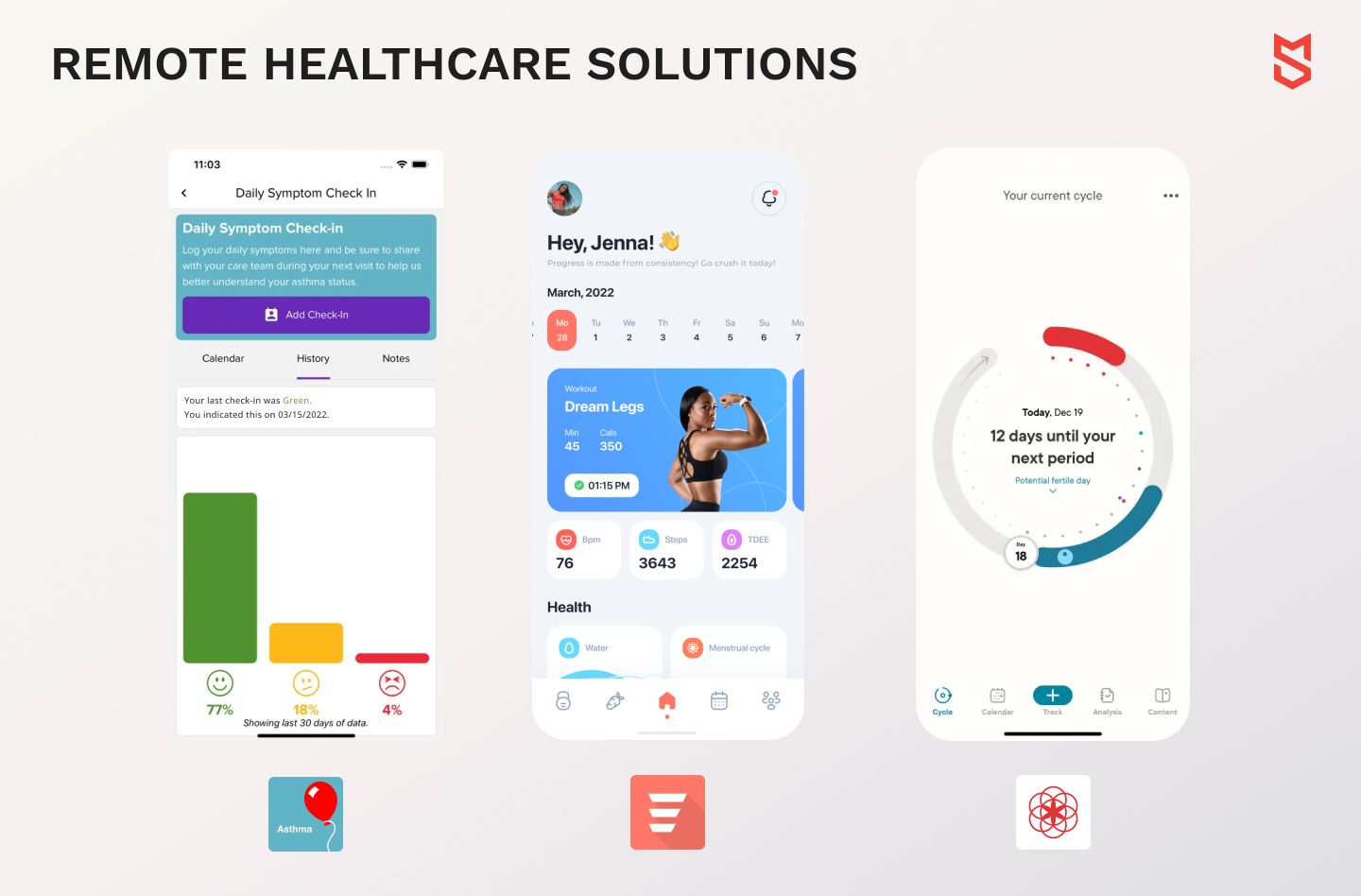
Digital health refers to using a wide range of technologies, but here, we’ll focus on those that aim to enable remote care and support.
The Philips Future Health Index 2022 report revealed that healthcare leaders view extending care delivery beyond the hospital as their biggest priority after staff satisfaction and retention. It makes sense for health tech companies to follow this trend closely for the next years.
While mHealth, digital therapeutics, and telemedicine fall under the same umbrella of technology-enabled healthcare, their focus differs.
mHealth
The mHealth trend (short for mobile health) refers to the use of mobile devices like smartphones to deliver healthcare services and support. It encompasses various apps for health tracking, remote monitoring, medication management, and more.
mHealth leverages the accessibility of mobile devices and thus supports healthcare professionals in empowering patients and encouraging them to manage their health proactively. Such apps can serve not only a wide range of users but people with specific, unique needs as well.
Example. Asthma Buddy is a mobile app that assists users with asthma in managing their condition through symptom tracking, medication management, peak flow monitoring, asthma action plans, and other features.
Digital therapeutics
This healthcare tech trend refers to software-based interventions created to prevent, manage, or treat various medical conditions. The interventions typically leverage digital technologies, such as mobile apps or web platforms, to deliver evidence-based therapeutic interventions that are clinically validated.
Digital therapeutics can be used independently or in conjunction with traditional therapies. They typically involve interactive platforms or applications that guide users through targeted interventions, such as cognitive-behavioral therapy, mindfulness exercises, or medication adherence programs. Unlike mHealth, these programs can be accessible not just through mobile devices but through computers as well.
Example. A famous case of this relatively new technology in healthcare is reSET, a prescription digital therapeutic created to help treat substance use disorder. It combines a patient-facing mobile app with a clinician-facing web interface to provide cognitive behavioral therapy-based interventions.
Telemedicine
The increasing prevalence of chronic diseases, rising healthcare costs, staff shortages, and lack of proper healthcare infrastructure, especially in remote areas, push healthcare organizations to seek more affordable and accessible care delivery options. Telemedicine is one of the keys to these challenges.
Telemedicine involves remote delivery of healthcare services, allowing patients to consult with healthcare professionals while reducing the need for costly in-person visits. It typically utilizes telecommunications technology, such as video conferencing and remote monitoring devices, to facilitate real-time interactions.
The most high-demand telemedicine solutions include:
- Live video platforms that enable real-time video consultations between healthcare professionals and patients
- Store-and-forward platforms where patients can upload their medical data, such as images or test results, to be reviewed by healthcare providers
- Remote patient monitoring services that involve the use of connected devices to monitor patients' health data remotely
- Online health portals that provide patients with access to their health records and allow for appointment scheduling and communication with healthcare providers
- Collaborative platforms for healthcare providers, which enable them to consult and share expertise remotely
All three trends are transforming the future of healthcare by offering innovative solutions that enhance patient care, improve outcomes, reduce costs, and optimize healthcare delivery. We are confident that these technologies are laying the foundation for future trends in healthcare technology.
Wearables and Internet of Medical Things (IoMT)
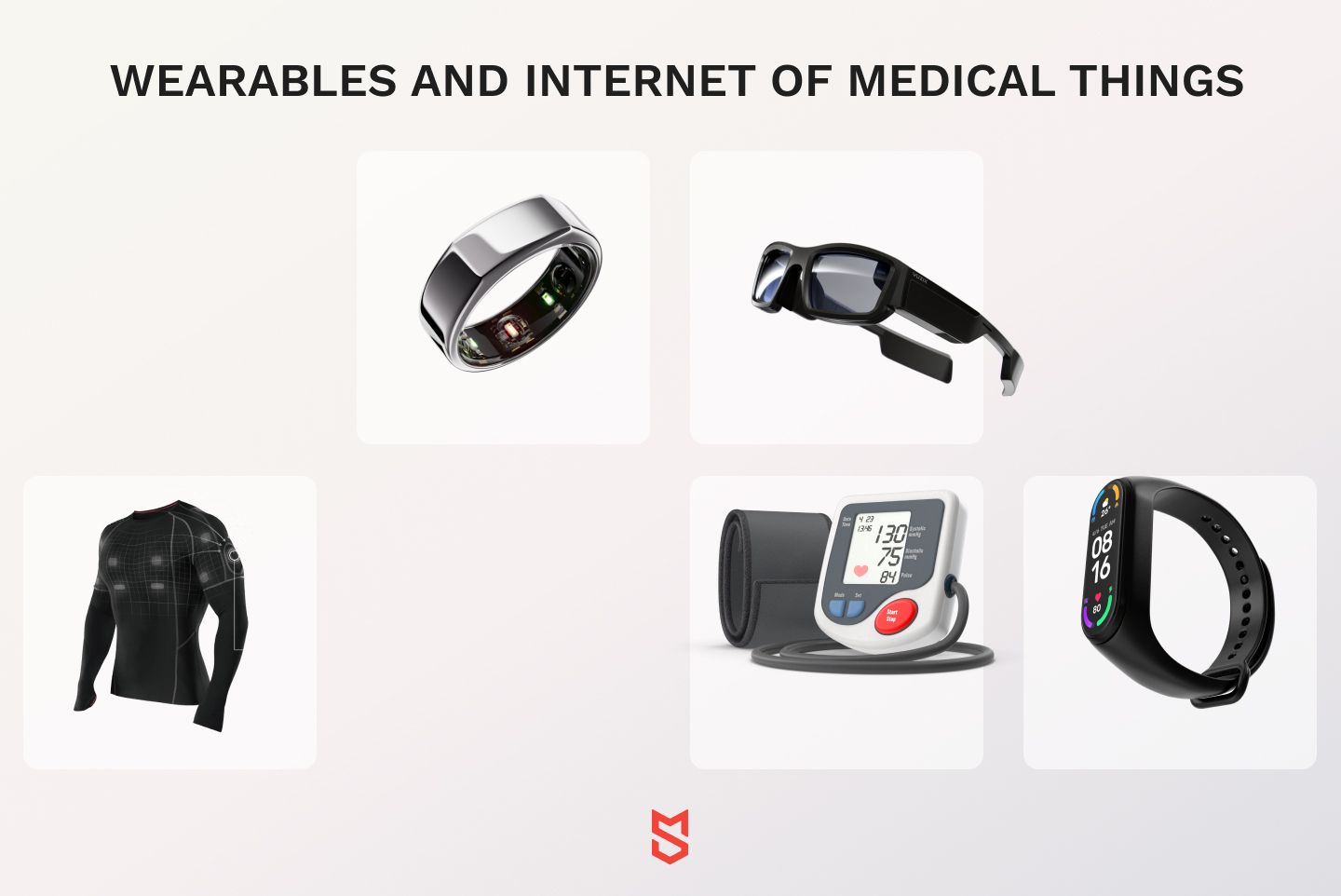
Wearables and the IoMT aren’t new technologies, per se. However, in 2023, they are thriving, with wearables projected to grow at a 9.1% CAGR and IoMT at 23.70% between 2023 and 2032. Besides, both wearables and IoMT devices are getting more advanced and diverse, meaning they have gone far beyond regular smartwatches.
Medical wearables are devices designed to collect health-related data from users. As for IoMT (Internet of Medical Things), it refers to the connection of these and other types of medical devices to the Internet, enabling data transmission and analysis.
Today, wearables and IoMT devices can collect the following data:
- Vital signs, such as blood pressure, heart rate, respiratory rate, oxygen saturation, and body temperature
- Sleep patterns like sleep duration, stages (light, deep, REM), quality, disruptions
- Physical activity, including steps taken, distance traveled, calories burned
- ECG and heart rhythm, which allows monitoring the heart’s electrical activity, detecting arrhythmias, etc.
- Signs and activities tracking which is vital for chronic disease management. These include monitoring blood glucose levels, tracking electrodermal activity, etc.
- Medication adherence, which enables sending reminders and recommendations on medication intake
- Stress levels through heart rate variability analysis
- Fall detection and location tracking, which is especially helpful for caregivers or emergency services looking after senior patients
- Environmental factors, such as UV exposure, air quality, temperature, humidity
This list is not exhaustive, and the specific data collected may vary depending on the device. Wearables and IoMT devices can come in the form of biosensors, smartwatches, smart rings, inhalers, clothing and shoes, posture correction devices, eyewear, earwear, patches, implants, and more.
Wearable technology and IoMT allow HCPs to collect real-time patient data, monitor patients remotely, and improve disease management. Moreover, these devices help detect various medical conditions, like mental illnesses or risk of heart attacks, early on, facilitating preventive and proactive care.
Example. A vivid case of health tech companies leveraging IoMT is Proteus Digital Health. This digital therapeutics company is one of the pioneers in using IoMT in medication management. Their digital medicine platform combines ingestible sensors integrated into medications, wearable patches for monitoring physiological signs, and a smartphone app to provide personalized healthcare insights and improve medication adherence.
Big Data and EHR
For those who work with healthcare-related projects, there is no need to get into what Electronic Health Record (EHR) systems are: they have been around since the previous century.
Big Data in healthcare refers to the large volume, variety, and velocity of structured and unstructured data generated within the healthcare ecosystem. It aims to extract meaningful insights, patterns, and correlations from this data through analytics tools. The healthcare Big Data analytics market is expected to grow from USD 215.71 billion in 2023 to USD 794.08 billion in 2030.
So, why have we put these two together? Well, as it turns out, EHR systems have significantly contributed to the generation and accumulation of Big Data in healthcare.
As you know, EHR systems are a primary source of structured patient data, such as medical history, genomic information, diagnoses, treatments, medications, and lab results. And all this data, when aggregated across multiple EHR systems, forms a substantial part of the Big Data ecosystem in healthcare.
In addition to analyzing EHR data, the technology can incorporate other data sources, like sensor and wearable device data, social media and patient-generated information, claims and billing data, etc.
As a result, healthcare organizations identify population health trends, discover patterns and correlations, predict patient outcomes, and make data-driven decisions for better patient care and operational efficiency.
Example. If you want to explore how this technology trend works in reality, we recommend looking into Tempus, a health tech company specializing in precision medicine. The Tempus team utilizes Big Data analytics to process clinical and molecular data. Thanks to this, they can aggregate and analyze large-scale genomic and clinical datasets to identify patterns, predict treatment outcomes, and revolutionize personalized care, specifically for cancer patients.
Cloud migration
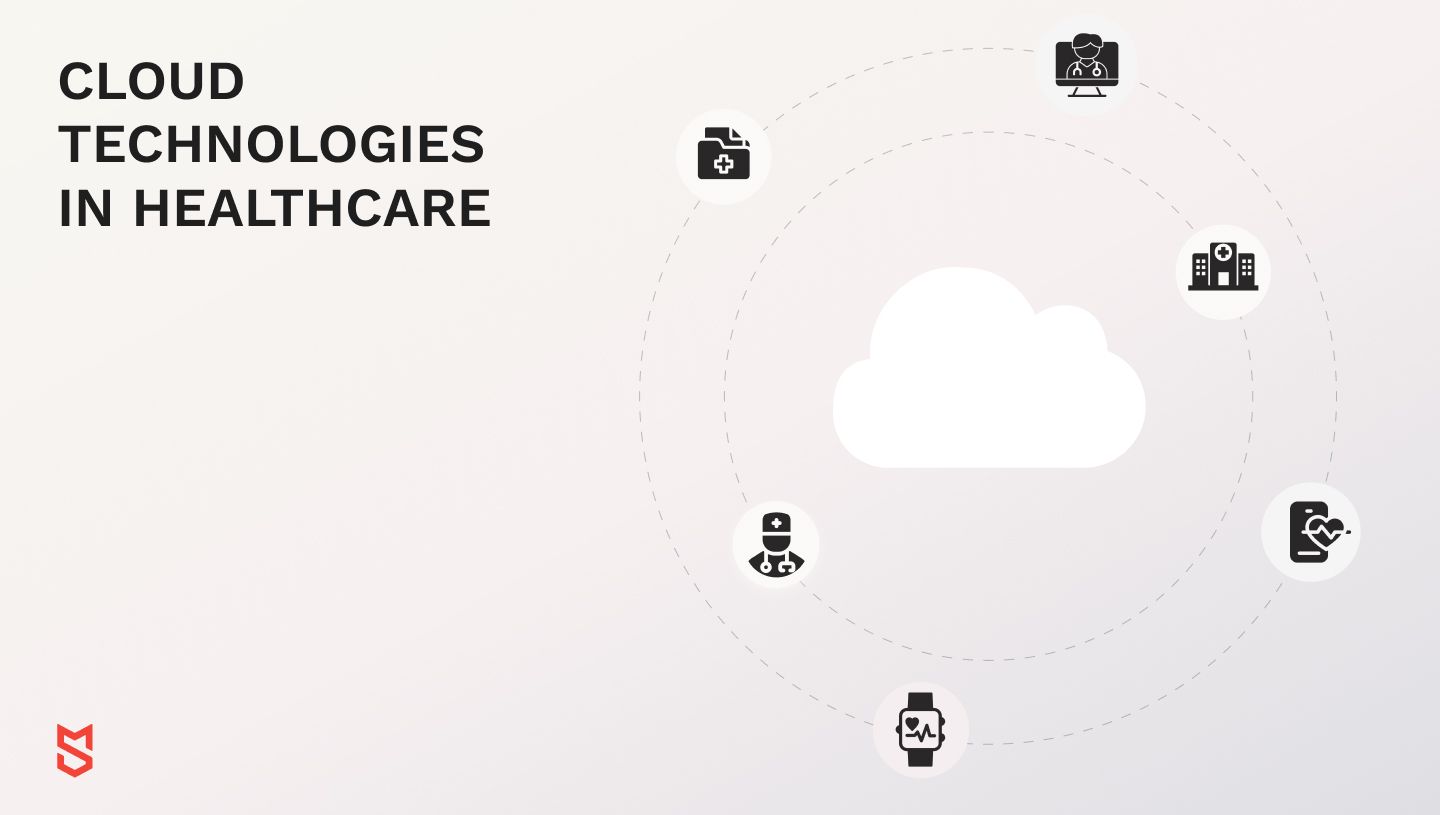
The healthcare industry has been embracing cloud technologies slower than other fields, mainly due to data security concerns. However, during the last few years, the adoption rate of cloud solutions in the industry has increased. A 2023 Duplo Cloud study showed that 70% of healthcare businesses have adopted cloud computing. It is also estimated that 90% of companies in the field will use some form of cloud computing by 2025.
Healthcare companies and organizations moving their data, applications, and IT infrastructure from on-premise systems to cloud-based platforms can win from:
- Seamless scalability and flexibility of IT infrastructures, which allows them to accommodate growing data storage and processing needs
- Advanced opportunities like on-demand resource allocation, data storage, and computing power
- More efficient collaboration between different healthcare providers
- Reduced reliance on physical infrastructure
- Enhanced data accessibility and operational efficiency
- Lower IT maintenance costs
Companies and organizations have several options when switching to cloud technologies. They can use public, private, community, or hybrid cloud models based on their needs and regulatory requirements.
The experience of large companies that build healthcare solutions plays a significant role in encouraging health tech companies to adopt cloud solutions. Among such examples to follow is Microsoft. Its cloud-based platform Azure is used for monitoring patient insights and analytics all within the cloud. Also, Microsoft’s Health Bot Service, a cloud-based AI platform, enables healthcare organizations to build and deploy intelligent chatbots.
It’s important to note that cloud technologies are incredibly versatile in their use cases. Healthcare companies can employ cloud technology for their Electronic Health Records (EHR) systems, Clinical Decision Support (CDS) platforms, Health Information Exchange (HIE) platforms, Picture Archiving and Communication Systems (PACS), remote monitoring and use of IoT devices, population health management, and more.
Blockchain and Data Security
Since data security and privacy are the top priorities for user-centered healthcare software, it’s no wonder blockchain technology has made the list of the most promising healthcare trends. It offers enhanced security, transparency, and efficiency in managing health data and other sensitive information.
Healthcare organizations invest in blockchain technology to deal with challenges like data breaches, data fragmentation, data disparities, and inefficient processes. Some of the most common use cases of blockchain technology in healthcare include:
- Secure and interoperable health records, which involves using blockchain for building a decentralized and tamper-proof system for storing and sharing EHRs
- Drug traceability and supply chain management, where blockchain is used to monitor the pharmaceutical products supply chain and prevent counterfeit drugs from entering the market
- Medical billing and claims processing with blockchain technology helping streamline and automate these complex processes in a transparent and cost-efficient way
- IoMT data management, where blockchain technology is used to store and manage data from wearables and other remote monitoring devices, ensuring data integrity, privacy, and reliable data sharing
- Identity management and patient consent, with the technology used to establish a decentralized, secure system that allows patients to control access to their health data
Example. Many healthcare companies and organizations have been utilizing blockchain for years but are now expanding this technology to other areas of their operations. For instance, Mayo Clinic started exploring blockchain for storing EHRs in 2018. However, now the team uses the technology for other purposes, such as clinical trials.
Augmented reality and VR
Augmented reality (AR) and virtual reality (VR) are relatively new technology trends in healthcare. However, they can transform various system aspects, including medical education and patient care.
Here are the two core use cases for AR and VR solutions in healthcare.
Medical training
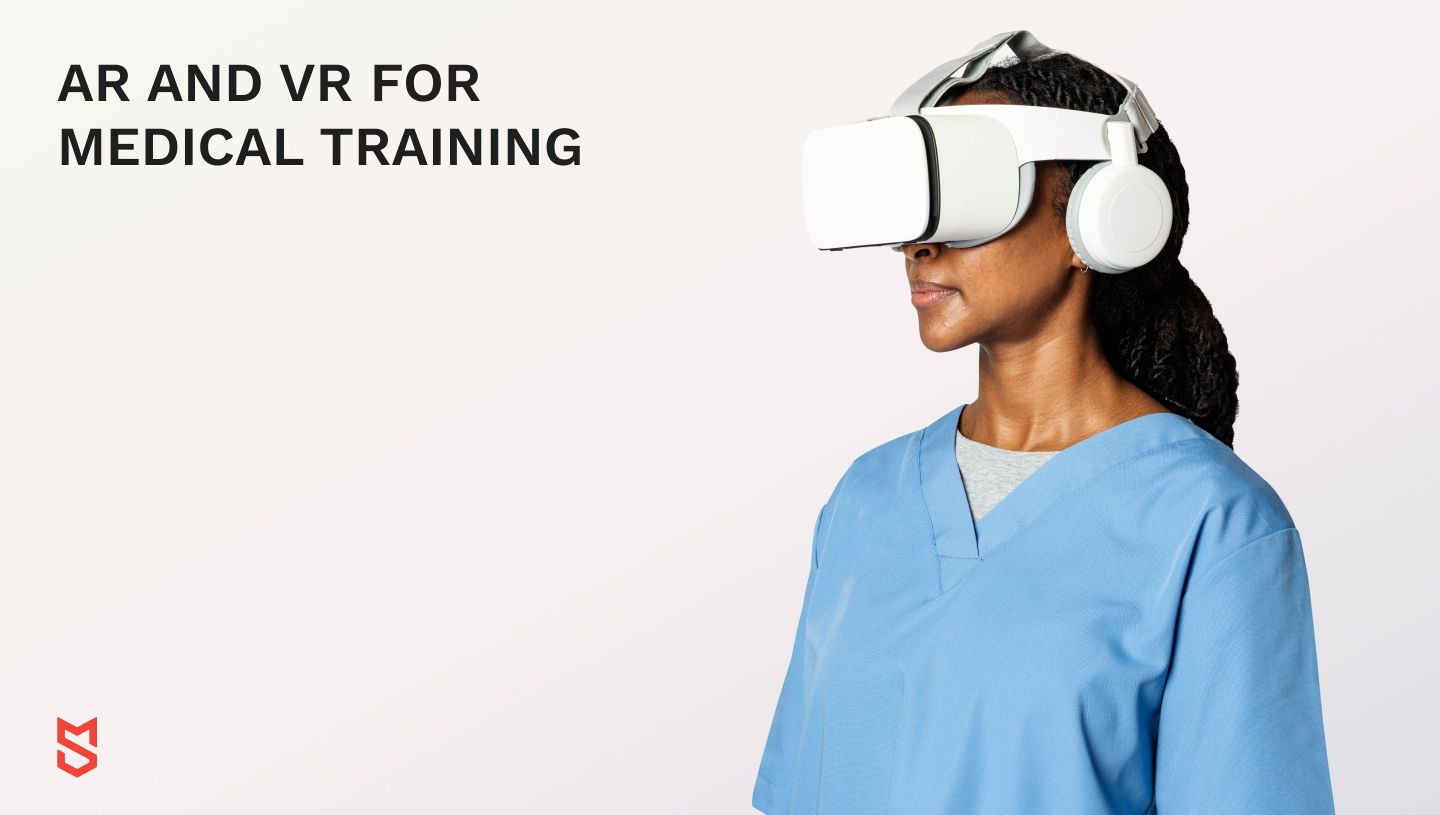
Students, interns, and even more experienced HCPs use augmented and virtual reality tools to explore detailed anatomical structures, visualize medical concepts, and practice performing complex procedures in a safe virtual environment, improving their skills and confidence.
Example. Among famous cases of AR/VR health tech products for HCPs is Surgical Theater's Precision VR platform, which allows surgeons to create detailed 3D models of a patient's anatomy from medical imaging data.
Patient treatment and support
AR and VR are used to improve diagnosis and treatment planning. For instance, surgeons use these technologies to practice before procedures and overlay digital information onto a patient's anatomy during surgeries, which provides them with guidance and helps improve surgical precision.
VR can also be used for distraction during medical procedures, pain management, virtual rehabilitation, living with developmental disorders, dealing with phobias, and more.
Example. Psious offers a VR-based therapy program for treating various anxiety disorders, phobias, and PTSD through exposure to virtual environments that simulate real-life situations and practice mindfulness.
Data interoperability
Interoperability made this list of key 2025 healthcare tech trends due to its potential to enhance care coordination and data sharing and thus improve patient outcomes. Let’s get into what it actually is and how it works.
Interoperability is the ability of different healthcare systems, devices, and applications to exchange and interpret data seamlessly. It involves standardizing data formats, protocols, and interfaces to ensure compatibility and smooth information flow.
As a result, healthcare providers can securely share and access patient data across different platforms and have a holistic view of this information, which includes medical history, diagnoses, treatments, and medications. This naturally promotes data-driven decision-making, facilitates better care planning and smoother care transitions, and reduces medical errors.
Example. The interoperability trend is quickly catching on with health tech companies. For instance, Epic Systems, an EHR vendor we at Mind Studios use in our healthcare projects, promotes interoperability through its Care Everywhere platform, enabling data sharing between different organizations.
Another example worth mentioning is CommonWell Health Alliance, a nonprofit industry association formed by a group of healthcare technology companies aiming to advance interoperability and data sharing in healthcare. One of its tasks is to facilitate the secure exchange of patient data across different EHR systems, allowing healthcare providers to access comprehensive patient information regardless of their EHR platform.
Securing interoperability is crucial for organizations and companies embracing other technologies on this list, such as telemedicine, remote monitoring, and AI, since they rely heavily on real-time data exchange.
Apply new healthcare technology with Mind Studios
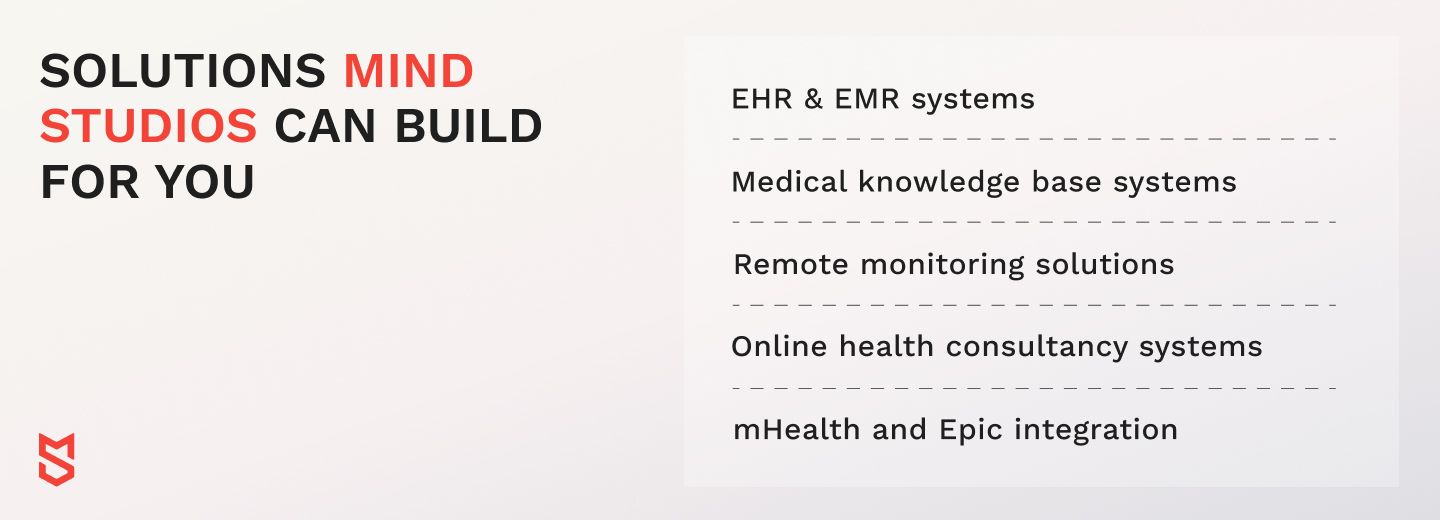
Our work in the healthcare industry started a decade ago, almost simultaneously with Mind Studios’ journey. Over the years, we’ve launched an app with a custom medical knowledge base system, developed an MVP for the first national EHR system in Ukraine, and helped create a holistic healing solution for people with injuries and chronic illnesses.
In this particular article, though, we’ll focus on two medical startups created for the same client.
Back in 2013, we connected with a US-based practicing doctor and UCSF teacher, who had an idea to develop a teledermatology platform aimed at helping people with various skin conditions through online consultations.
The service had to allow users to pick the exact body area they were struggling with, attach pictures, and get automatic treatment recommendations. And since AI and ML solutions weren’t as accessible as they are today, we had to develop an Excel-based algorithm to automate those initial recommendations manually.
The platform became profitable and had a team of numerous talented dermatologists on board. After nine years of leading the business, our client successfully exited the project (which is why it is under the NDA now) and moved on to other goals. A decade later, in 2025, we are working on another project for this same client.
While it’s under development, we can’t share many details about the new service. However, we can say that it will help healthcare professionals collect necessary medical information before the appointments and thus focus on patient care, making the visits as efficient as possible.
Currently, we are adjusting the software to meet all the necessary regulatory requirements and getting ready to enhance it with an NLP chatbot, so stay tuned for further updates.
Armed with the knowledge we’ve been accumulating for the past ten years, the Mind Studios team is open to developing other impactful healthcare projects, whether it’s an EHR system, an mHealth app, an AI-powered telemedicine platform, or something completely different from what the market has seen so far.
From following health tech trends to adopting them
The rapid advancement of digital technologies, staff shortages, and continuously rising patient expectations mean implementing modern technologies is not a mere competitive advantage but a crucial necessity. And the longer health tech companies wait to adopt these new medical technology trends, the harder and costlier it will be to catch up later.
It’s hard to argue that AI or IoMT projects can be expensive. However, a small start (like training a ready-to-use AI model or upgrading your existing software) is still a start. Besides, outsourcing IT services to a company like Mind Studios can help you cut costs while still building a platform that serves patients and HCPs.
Whether you have clear health tech ideas or are just exploring how to leverage the above-mentioned technology trends in healthcare projects — Mind Studios is happy to help you figure out the optimal IT strategy that matches your needs, goals, and budget. Fill in a short form, and our business development team will schedule a free consultation for you.


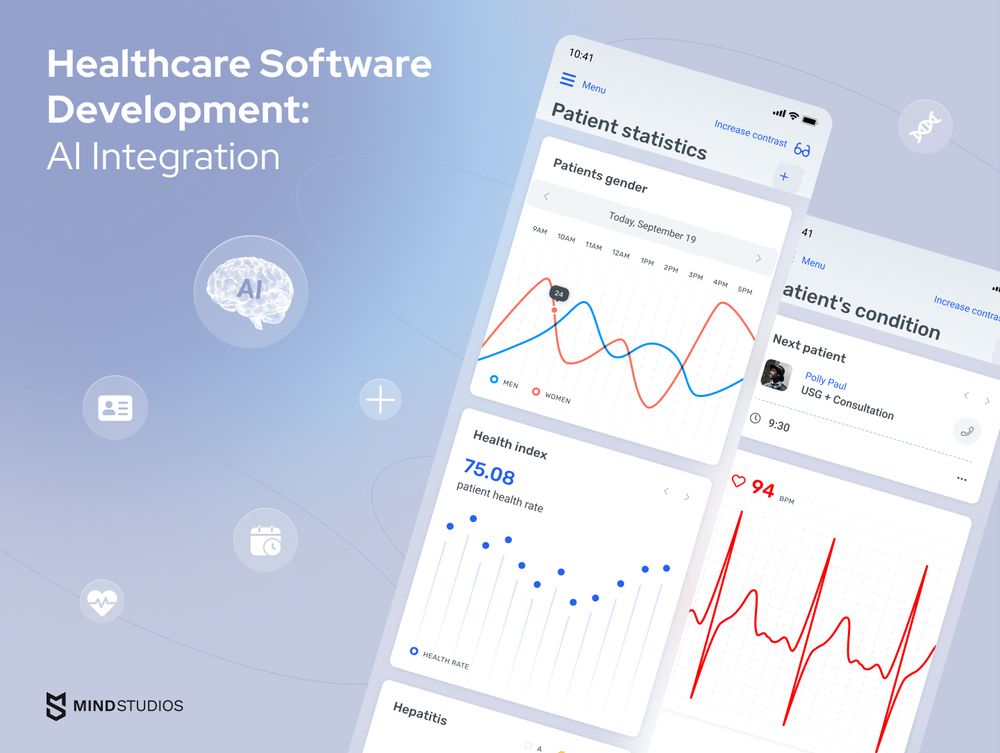
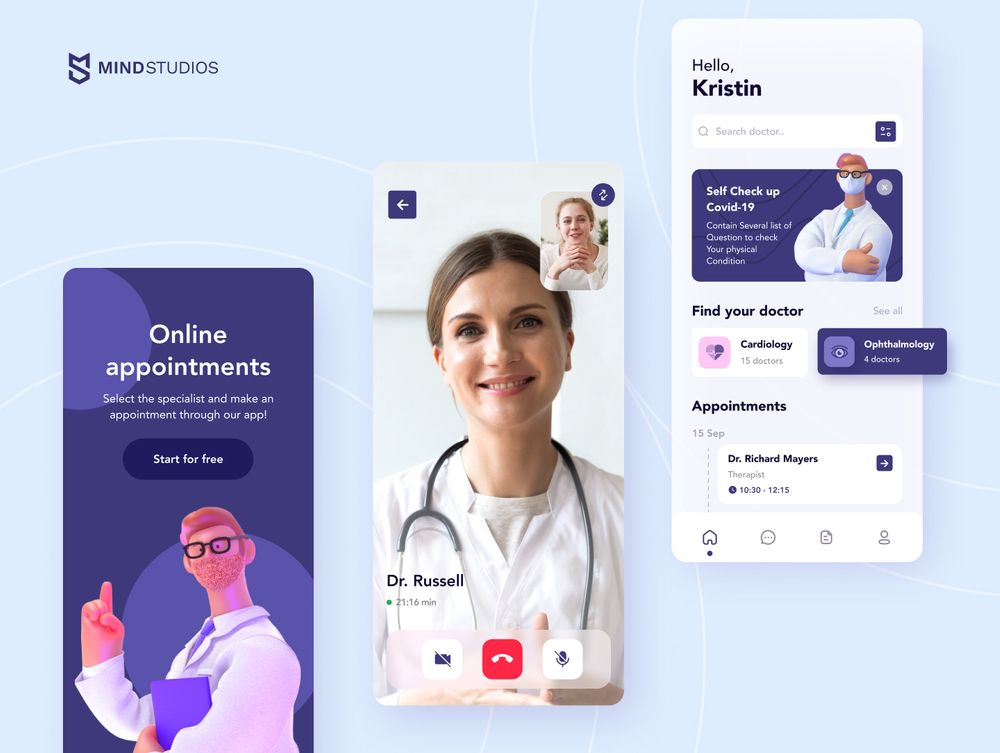
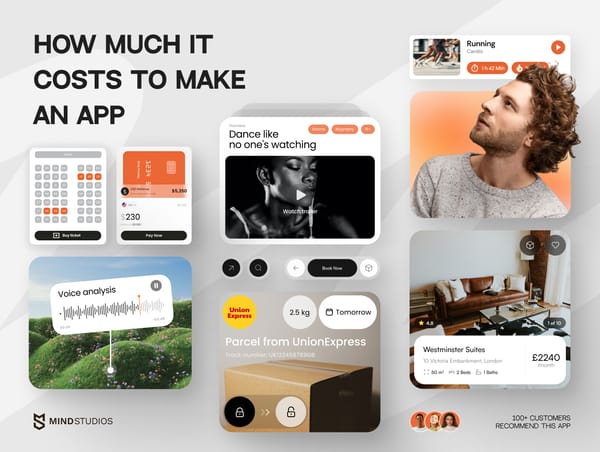
![How to Create an On-Demand Medicine Delivery App [Expert Guide]](https://themindstudios.com/blog/content/images/size/w600/2025/03/IMG-1-Cover-6.jpg)
